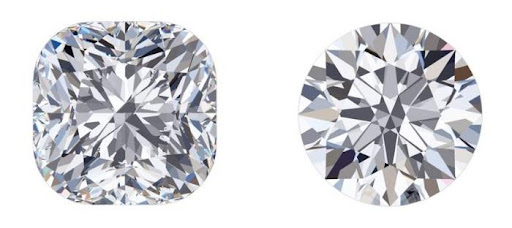
Earlier this week, we talked about how to discover the right combination of diamond size, color, clarity, and cut for your budget. Diamond quality combinations specific to round and cushion cuts are the focus of today's post. It's important to remember that these are merely suggestions and that beautiful gems might be found inside or outside of these parameters!
Cut: If you're looking for a good cut, look for a Very Good or Excellent cut. Excellent is always preferable, but if you're looking to stay within your budget but still want a larger carat size, better clarity, or more color, consider going with a very good cut. It's hard to tell the difference between an exceptional and a very good diamond when they're side by side and placed in a ring. Despite this, I've seen some good-cut diamonds that look great as well, and this isn't necessarily a bad thing!
Diamonds in the round shape perform an excellent job of masking color and flaws. Because they are precisely cut, round brilliant diamonds offer the most radiance of any diamond shape.
Color: For round cuts, a J color is the minimum recommended color. Face up, a near colorless round cut has a white appearance, even though J is the end of the Near Colorless range. Of course, if you're color-sensitive, you should go with a higher color, since the difference can be clearly noticed when compared side-by-side, but once put in a ring, these will look fantastic. That doesn't mean you won't notice a difference between a "E" and a "I" color next to each other, but in most cases, you can get away with a lower color.
Clarity: Because they have so much glitter, you can go with SI2 clarity or better in terms of clarity. It's important to note that not all SI1 and SI2's are eye-clean, so this will be a case-by-case consideration. There are three things to keep in mind when it comes to the inclusions: their location, color (black inclusions tend to be more obvious), and type (diamonds with many clouds will appear hazy)
CUSHION With soft corners, they come in a wide variety of shapes and sizes.
Cut: Due to the fact that cushion-cut diamonds are considered "fancy diamonds," the GIA does not issue an accurate cut grade on the diamond certificate. The diamond's cut must be evaluated on the basis of the stone's length, width, depth, and all other proportions. Pillows should have a length to breadth ratio between 1:1 and roughly 1:1.2 (approximately) if you want a more rectangular/elongated appearance. Elongated cushions tend to look larger since they take up more finger length.
It is possible to choose from a variety of cushion styles. The Cushion Modified Brilliant is the most prevalent type of cushion. Crushed ice" is the term we use to describe the sparkles that appear in these pieces. This type of cutting is more common. An ancient cushion that emits big chunky flashes of light is also extremely rare. There are a couple of other kinds of cushion cuts, but we choose Cushion Brilliants for usage in rings because of their larger-than-average face up size and crisp, clear faceting. GIA-reported diamonds labeled as cushion modified can nevertheless have the beauty and optical qualities of a cushion brilliant if the pavilion facets are positioned correctly.
Color: Cushion cut diamonds with the crushed ice effect are more likely to display color. If you want an extremely white customized cushion, go with a color I or higher. A J color might seem white on the face of a cushion spectacular style cushion because it hides color very well. You can play with a slightly lower color and yet have a diamond that seems white, dazzling, and sparkling face up with the cushion brilliant cut diamonds.
Clarity: Cushions with clarity of SI2 or higher will be the standard. Cushion cuts, like rounds, are ideal at masking faults since the clear facets and shine deflect the eye from any imperfection and it will be hard to see with the naked eye. There are eye-clean SI2 cushion modified diamonds as well as the more common crushed ice style cuts, which are morone to flaws.
We'll cover the remaining diamond cuts and attributes in detail in our upcoming piece, so stay tuned!
Sell your diamonds with ease with Diamond Registry’s comprehensive approach and vast global industry connections to help you find the best buyer for your diamond fast. Visit www.diamondregistry.com/sell-your-ring to take your first step to fast, easy and reliable way of selling your diamond.
Want to check and calculate diamond per carat instantly? Go to DR’s diamond price calculator www.diamondregistry.com/diamond-price-list/#calc-move-to to know how. Reliable and trusted carat calculator in the diamond industry since!

